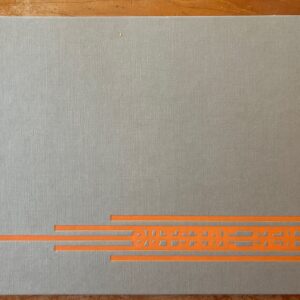JTF (just the facts): A total of 43 black and white photographs, framed in blond wood and envelope matted, and hung against white walls in the single room gallery space. All of the works are posthumous gelatin silver prints, made by Gunther Sander in 1976 from August Sander’s negatives (originally from 1911-1932). Image sizes range from roughly 6×9 to 8×11 (or reverse). (Installation shots below.)
Comments/Context: As I sat down to write a review of this intimate gallery show, it became clear that there is a certain dilemma involved with trying to review a monumental classic of photography like August Sander’s People of the 20th Century. Sander’s project to comprehensively document German society is so well known and so deservedly influential that few additional words seem necessary to complete its beatification. As a collector, if you are aware of Sander’s project, it is already cemented in your mind as a photographic masterpiece, and if you are a new collector just discovering Sander for the first time, I expect you will be appropriately wowed by its durable power. So either this show is a straightforward reinforcement of something you have already internalized (perhaps long ago) or a once-in-a-lifetime mind blowing experience.
In 1977, Aperture published a summary volume on August Sander’s work as part of its now famous Aperture History of Photography Series, and the 43 prints on view here (sequenced in the same order) are the ones used for the book; in the intervening years, the prints stayed together and are now in the hands of a private collector. While People of the 20th Century was ultimately published as a carefully researched, academically rigorous, seven volume set of books encompassing some 619 portraits (with specific hierarchies and groupings), Aperture’s edit was more broad based, aimed at introducing the master to the American audience (it was the first book on Sander published in the United States). It gathers together both classics and lesser known portraits, single images and groups, and works made over several decades.
August Sander died in 1964 and these prints were made posthumously by Sander’s son Gunther in 1976. And as I looked over the images of the famous Pastry Chef, Peasants Going to a Dance, Boxers, and others, I started to wonder about the many complexities in the market for Sander’s work. And so testing the ever kind patience of gallery owner Deborah Bell, I began to ask questions about the various Sander prints floating around and how collectors can understand the differences between them. What followed was a clearly delivered basic tutorial in Sander connoisseurship, the key points of which I have tried to recreate below. So in lieu of an obvious “review” of the images themselves, I hope the information below can provide a solid first level primer for those considering acquiring Sander prints.
Collector’s POV: At the highest level, there are three (or maybe four) “kinds” of Sander prints – those made by August himself, those made by his son Gunther, and those made by his grandson Gerd. There are also some recent inkjet prints, which I will detail at the end of this summary.
The reality is that there aren’t many prints made by August running around any more. Many have been gathered at the August Sander Archive in Cologne and at the Getty, among other institutional locations. Those that are available are generally signed, as Sander tended not to print extra images ahead of demand and left few unsigned prints when he died; most are in the smaller roughly 10×8 size, although some larger prints were also made. A vintage print of the Pasty Chef was available at Galerie Julian Sander (here, another generation down from Gerd) two years ago for roughly $1 million, and other vintage August-printed portraits from the series consistently fetch six figures when they intermittently find their way to the secondary markets. The exception to this rule is Sander’s landscapes, which can often be found at reasonable prices in the sales of the German auction houses; these were generally printed/signed by August and have not been reprinted by the later generations given lesser demand.
Prints by Gunther Sander, like those in this exhibit, are generally displayed in envelope window mounts, with or without Gunther’s signature or other identifying numbers/inscriptions – it seems these prints were not consciously editioned or tracked in a detailed way, although they weren’t made in large numbers for any of the images. At auction, Gunther’s prints generally start at roughly $10000 and range up to five and six figures for the most iconic images. This selection of rare prints is being sold as a set, with the price available on request; there is one variant cropping of an unemployed man, which is worth seeking out.
The prints made by Gerd Sander (and Jean-Luc Differdange) were managed with much more systematic care. Staring in 1990 and continuing for straight ten years, Gerd made an edition of 12 prints each year. 12 was a maximum number, and not every image was printed all the way to 12 in each year. Each print has a black ink border and is displayed tipped onto a mount, with Gerd’s signature, the date, and the edition number on the back. So for Sander’s most famous images, Gerd likely made a total of 120 prints during the 1990s (12 x 10 years). These prints are now widely available at auction, starting at roughly $5000 and going up from there, and these are of course the most affordable Sander prints available. As an aside, the prints in MoMA’s recent acquisition of the entire set of 619 prints from People of the 20th Century were made by Gerd Sander; this full institutional-designed set was made in an edition of 7.
In recent years, six of Sander’s most recognizable portraits have been reprinted by Die Photographische Sammlung/SK Stiftung Kultur. These are inkjet prints, in editions of 150, in two sizes, available for a few hundred Euros.
I am certain this short summary isn’t perfect, so I hope that the many Sander experts out there will add to, expand, and correct my explanation in the comments as appropriate. The goal is to create a clear framework for collectors so they can understand what they are looking at when they come upon a Sander print in a gallery or at auction. Given the framework above, we can now see that the prints on view at Deborah Bell are indeed quite scarce at this point; the likelihood of seeing so many Gunther Sander prints in one place going forward is very low. So given the “review” conundrum described above, I’ve split the rating down the middle at 2 STARS, to both acknowledge the masterpiece quality of the images on view, but also to realize that for those who already know Sander’s work well, these prints will be of interest mostly for academic comparison and in the choices and sequencing of the Aperture edit.












